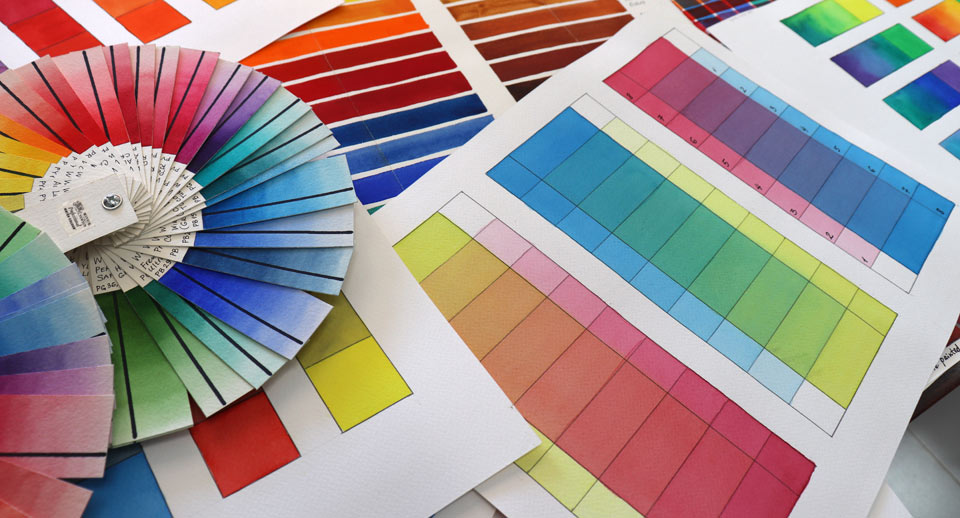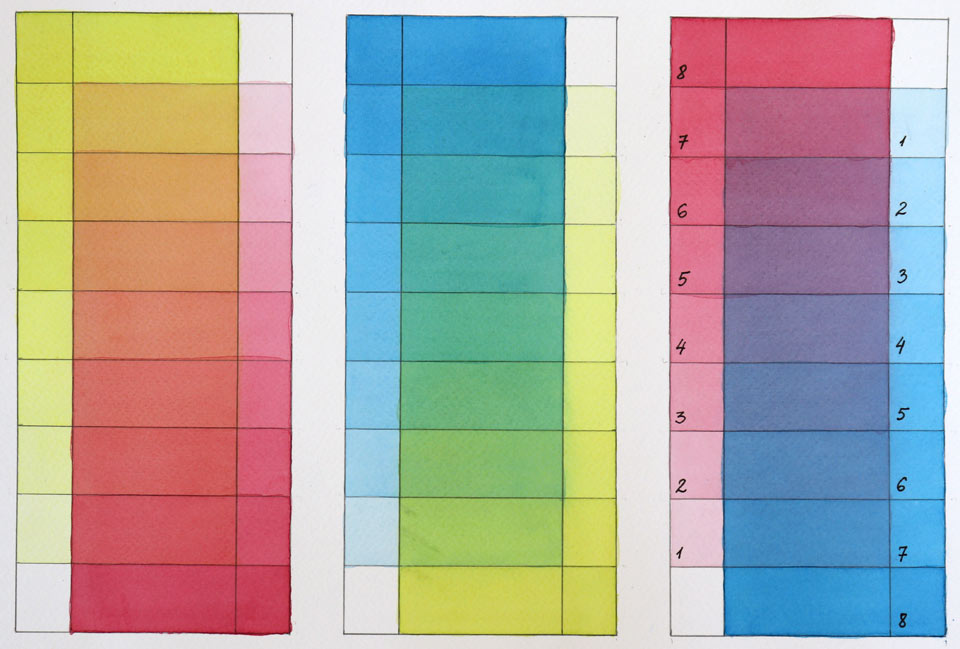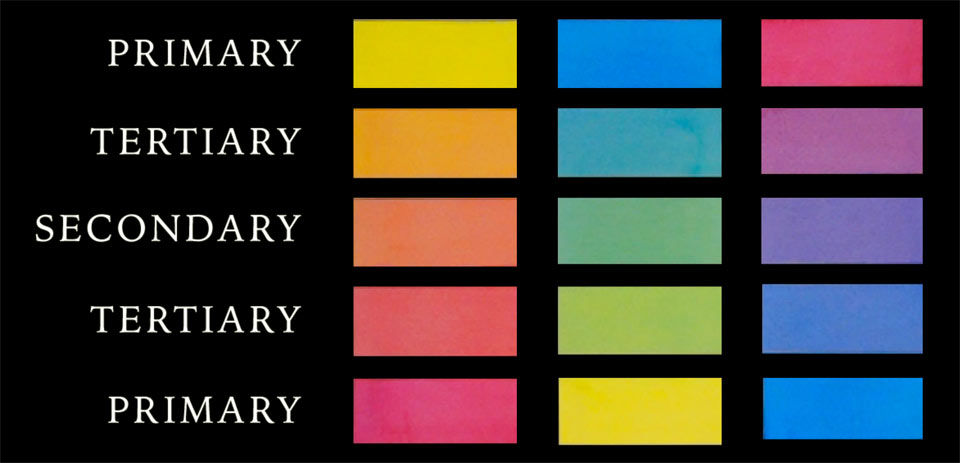A self-study, self-paced course where you can learn how to paint in watercolor by watching video lessons and doing assignments
$297 USD
ENROLL NOWA self-study, self-paced course where you can learn how to paint in watercolor by watching video lessons and doing assignments
$297 USD
ENROLL NOWOne-to-one, unlimited and custom-tailored to your skills and needs Personal Tutoring by the Watercolor Academy teachers
$997 USD
ENROLL NOWVideo lesson by Vladimir London
In the next few videos, you will discover the main principles of color theory, and its applications in watercolor painting.
In this video, we will cover primary, secondary and tertiary colors, and how to obtain secondary and tertiary colors by mixing three primaries.

When watching these videos, you may wish to make some notes in your sketchbooks, or even make some illustrations, so that you build your knowledge of color theory, and can keep it for future reference.
To prepare for the practical part of this lesson, draw three vertical rectangles, and divide each rectangle into nine rows. Also, add two narrow columns at both sides of each rectangle. When the rectangles are done, you can premix three primary colors, which are yellow, red and blue. From your paint box, pick any colors that look the most yellow, the most red and the most blue to you. Don't ask me which pigments I am using, because if you don't have any particular pigments, I do not want you to go into the shop or spend any time searching where to buy them online. Just pick three paints from the colors you already have. You will also need a paintbrush; I am using a natural-hair brush from Escoda.
Let's begin. There are three primary colors: yellow, red and blue. Conventional color theory says that none of these colors are obtainable by mixing any other colors. However, there are many other colors that can be obtained from mixing these three primaries. In this video lesson, we will see how this works.
The yellow paint which I am using is diluted with water. You may see that I am not applying it with a full strength; for now, I am just accurately filling a vertical rectangle with a light-yellow tint. While I am at it, I have to say a few words about color theory terminology.
When talking about colors, some artists may use words such as 'color', 'hue', 'pigment' 'dye' and 'paint' interchangeably. To agree on the terminology, we have to define those words. 'Color' refers to the visual sensation of how the human eye and brain conceive different wavelengths of visible light – in other words, this is what we see, which is colored light.
I previously mentioned that 'color' refers to the visual sensation of how we perceive visible light. There is another word to define color – which is 'hue'. 'Hue' is defined as the basic or source color, such as yellow, red, orange, green, blue and violet, without taking into count the hue purity. Hue purity itself has another word for it, which is 'saturation'. I mentioned that 'hue' is the basic or source color, without taking into account its saturation or purity. This means that, for example, a light red color is pink, but it still has a red hue. Also, yellow ochre is less saturated than Aureolin, but they both have a yellow hue.
Let's return to the exercise. I have completed the first layer of red paint, and now will add a layer of blue paint, which is also diluted with water to achieve a light blue tint. I am applying this tint from the first row, covering the left-hand side column and leaving the right-hand side one unpainted.
So far, I have mentioned what the difference is between color, hue, saturation and chroma. But there are other words such as 'pigment', 'dye' and 'paint' which describe the physical substances that artists paint with. Let's examine the difference between these words. Pigment is a physical matter which does not dissolve in water, and reflects certain wavelengths of visible light. It refers to tiny particles of matter that are used in paint manufacturing. Dye is also used for making paints, but it is a fully dissolvable in water colorant that is usually staining, and therefore it is used for paints. Lastly, paint is a mixture of pigments or dyes with binders and fillers, that artists use to create colorful artworks. There are single pigment paints and convenience mixtures. First contain just one kind of pigment or colorant, while others may have two or more.

So, here they are: the 8 steps of red color, every layer of which was painted wet-on-dry. This means that we can see clear borders between steps.
Here are eight steps of the blue color. You can see how the saturation of this color increases with every step, and its tonal value goes from light to dark tones.
Let's have a look at the fourth step, where equal amounts of red and blue pigments are optically mixed together. The mix of red and blue produces a violet color.
The mix of yellow and blue gives us a green color. And yellow and red results in orange. These orange, green and violet colors are called 'secondary colors', as they are obtained by mixing two primary colors.
You might be wondering why the orange color doesn't appear very orange, why the green color is not the best green that you have ever seen, and why the purity of the violet color is questionable. If you used different yellow, red and blue pigments, your secondary colors will be different as well. This is not because color theory doesn't work, but is down to the purity of primary pigments. You may wish to check out an interesting book by Michael Wilcox – "Blue and Yellow Don't Make Green", where he talks about color theory and the limitations of real pigments.
Now, let's return to our eight steps (as an aside, the number of steps is completely optional – you can complete as many as you would like to). What will happen if you mix a secondary color with a primary one? Steps number two and six give us a red-violet color. It has three parts of red, and one part of blue; this type of color is called tertiary. However, if you mix one part of red and three parts of blue, a blue-violet color will be produced, because it is equally distanced from the primary blue and secondary violet. The mix of primary and secondary color gives us the tertiary one. One part of blue and three parts of yellow result in a yellow-green color. By mixing one part of yellow with three parts of blue, we obtain a blue-green color. Mixing orange with yellow gives us yellow-orange. And red-orange is obtained by mixing red and orange colors.

There are three primary colors: red, yellow and blue.
When any two primaries are mixed together, they produce a secondary color - these colors are orange, green and violet.
When any of these secondary colors are mixed with the primary one, such a mix results in a tertiary color. There are six of these: yellow-orange, red-orange, red-violet, blue-violet, blue-green and yellow-green.
A self-study, self-paced course where you can learn how to paint in watercolor by watching video lessons and doing assignments
One-time payment - Lifetime membership
$297 USD
One-to-one, unlimited and custom-tailored to your skills and needs Personal Tutoring by the Watercolor Academy teachers
One-time payment - Lifetime membership
$997 USD